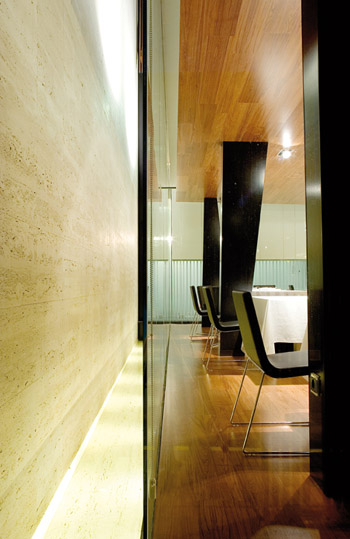|
...In a plot with
a single 8 m frontage and three party walls in the very centre of San
Vicente del Raspeig, the project consists of two separate buildings that
create different lighting spaces ... The first, cubic and precise, floats in
a sheet of water and stands apart from the second, generating two rifts on
the perimeter, expanding the interior space ... The first building acts as
the main dining room. Secretly entering the first fissure in the building, a
gentle ramp over the water leads to the entrance ... The water mitigates the
climate and at night it lights up every hollow in the blocks ... The second
or service building is more vertical. It holds the cellar, toilets, pantry
and kitchen and a private function room on the top floor, all connected by a
service lift and an elegant staircase. The kitchen is located in the section
on the middle level to serve the different rooms of the restaurant. From the
summer terrace it looks like the stage set of a laboratory ... As the views
were not too encouraging, we decided to use screens to make the interior
independent of the exterior. A wrapping of vertical battens folds in between
the two blocks, filtering the light and providing protection from the
afternoon sun. Its texture recalls the rhythm of a musical structure, giving
the project a certain air of privacy and sophistication ... The building is
hidden from the street and the interior reveals itself as we draw near to it
... The materials are light, water, glass and mirrors as virtual elements
and the warmest, most timeless stone, steel and wood ... One of the ways to
create a comfortable space for a restaurant was to treat it as a haven in
the city, paradigm of all habitable space.
  |

 |




 aaaaaaaaaaaa
aaaaaaaaaaaa






